How to see stars and planets near the sun?
In "astronomical calendars" you can often see phrases like "The sun will go into the constellation Taurus ", " Mercury in the upper conjunction with the Sun ", etc. It would seem that there is no practical meaning in them, because next to the Sun, nothing can be seen in the sky.

In this photo you can easily recognize the Pleiades - an open star cluster in the shape of a small bucket, usually decorating the winter night sky. But what kind of rays diverge from below? Light from a street lamp? No, these rays are part of the solar corona, and the sun itself is very close, behind the lower edge of the image.
To see the stars near the Sun, you need to create an artificial eclipse. No, do not block the sun with a coin. Such an eclipse has already been created and has been going on for almost 20 years. It takes place on board the SOHO space observatory . The observatory is a joint project of NASA and ESA, and was launched by the Atlas II-AS rocket from Cape Canaveral on December 2, 1995.
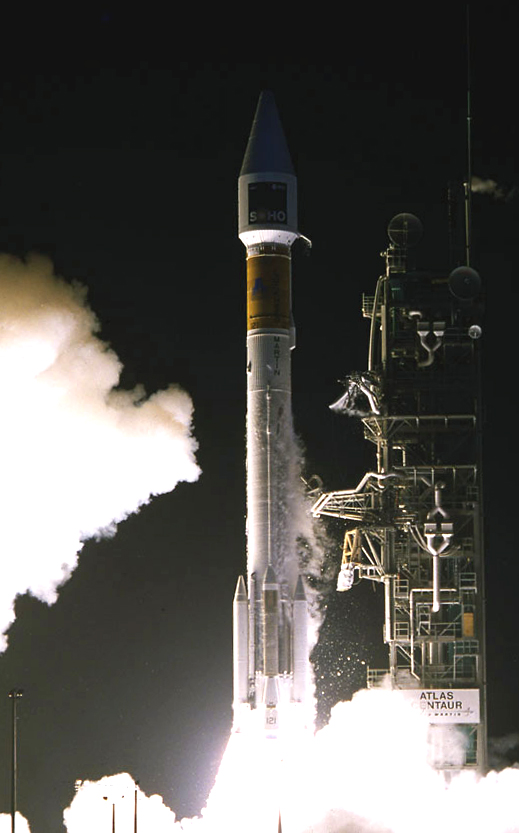
SOHO is located at the Lagrange point L1 of the Earth-Sun system. This is the point between the Sun and the Earth, one and a half million kilometers from the Earth (4 times further than the Moon). More precisely, the device is in the so-called halo-orbit around the point L1:
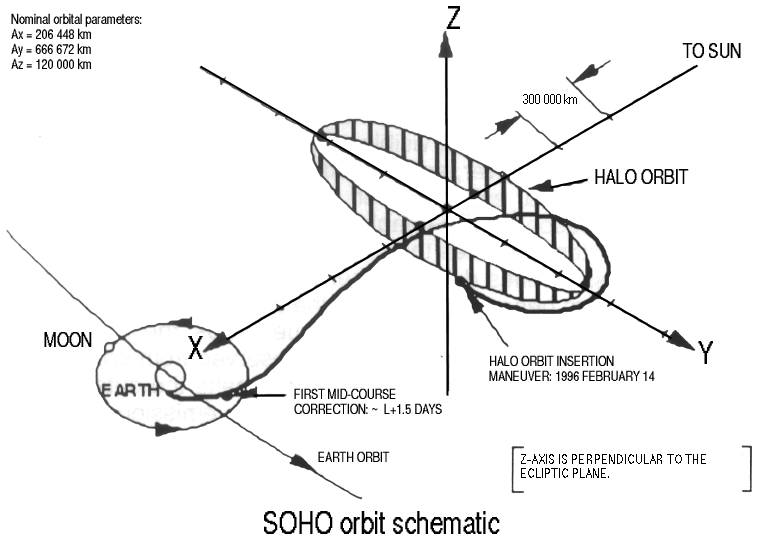
Thus, the observatory can conduct continuous observations of the sun 24 hours a day and seven days a week. The view of the starry sky from the SOHO in the direction of the Sun is practically no different from what we see from the Earth, except for the absence of the Moon. There are many instruments on board to observe the surface of the Sun, but I will not consider all of them in the framework of this article. We want to see the stars near the Sun, and here the LASCO tool will help us .
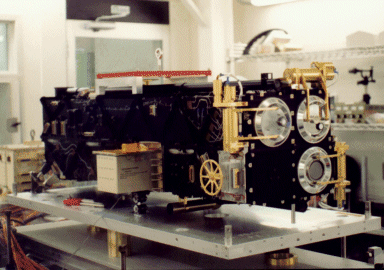
LASCO consists of three coronographswith different sizes of field of view. A coronograph is a special telescope that allows you to observe objects close to the Sun. In the center of its field of view is a disk blocking direct sunlight, allowing you to see the solar corona, as well as stars, planets and solar comets. The most wide-angle coronograph LASCO C3 shoots in visible light and covers the region of the sky around the Sun with a diameter of 16 degrees. Consider one of the Lasco C3 snapshots:
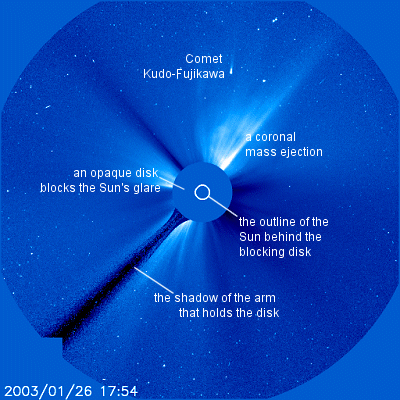
Blue coloring was added artificially here to easily distinguish pictures of different instruments, in fact, the photograph is monochrome. In the center of the image, we see a shadow of the screen overshadowing the image of the Sun (the so-called “artificial moon”). A small white circle shows the position of the solar disk. The blurred diagonal strip is the shadow from the bracket on which the "artificial moon" is suspended. As we see, the device sees not only the crown, but also many faint stars in the background. The comet also fell into the frame.
Currently, Lasco C3 takes pictures every 12 minutes. Images are stored on board the device, then for several hours they are transmitted to Earth using the DSN network and become available to everyonein resolution 1024x1024. Let me remind you that the device is 20 years old, and for the 90s it's pretty cool, then the top digital cameras had a resolution of 0.3 megapixels (640 × 480). Take a look at the larger picture.
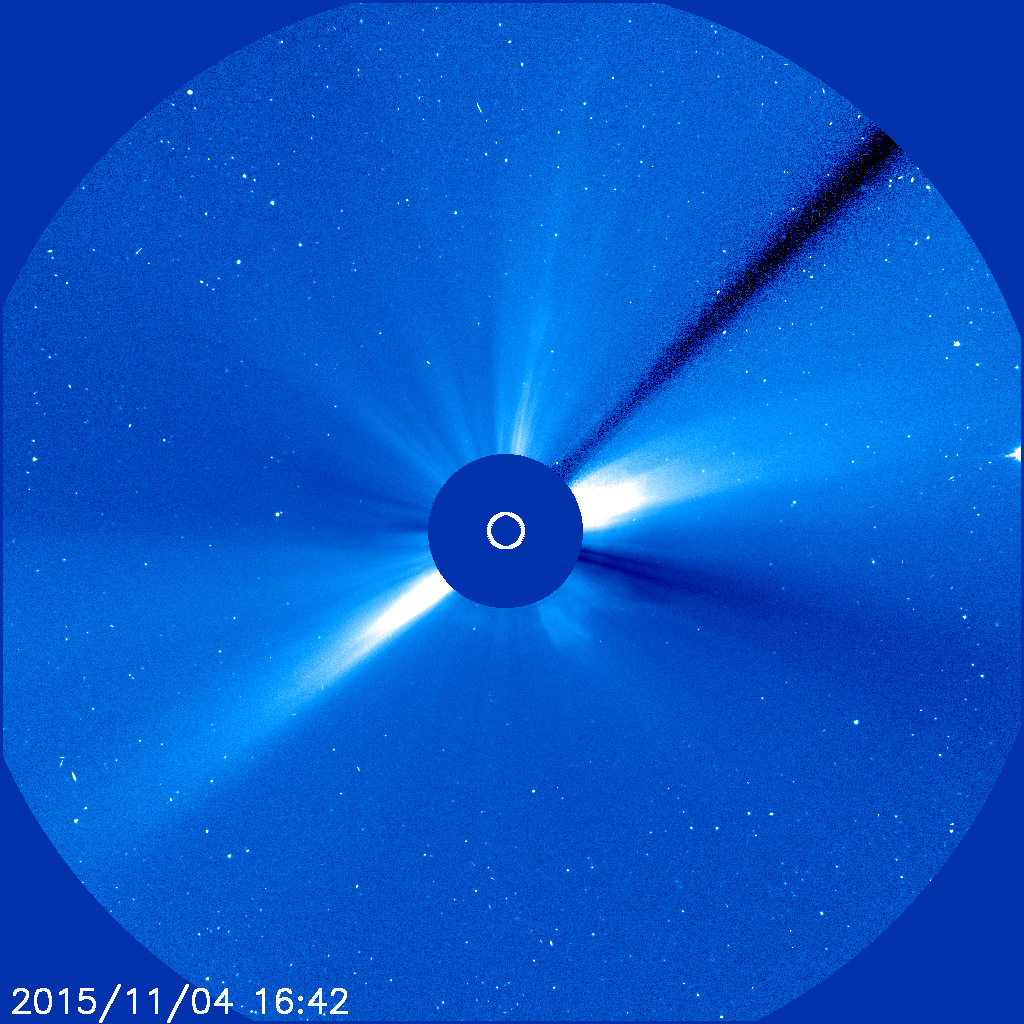
It has a lot of noise caused by cosmic rays. Dust particles flying in the sunlight form all kinds of strokes and dashes (shooting is carried out with a shutter speed of 19 seconds). Fortunately, the pattern of fake stars randomly changes from one image to another, sometimes forming the effect of cosmic snowfall . Real stars do not shift much. Therefore, to observe stars is better to collect the animation (on SOHO can find ready-made short SIFCO and empegi. I wanted to put together a high-resolution video spanning several months. To do this, I had to download a dozen and a half gigabytes of images (from April 10 to September 10, 2015). This is what happened (it’s better to watch fullscreen with maximum quality).
The video contains youtube annotations to help identify objects in the frame (do not work on mobile devices). See the table for more details:
Tomorrow Mercury will appear in the field of view of LASCO C3, and Saturn will appear on November 21.
It is interesting that in 1998 SOHO was almost lost due to the failure of three gyroscopes at once. Fortunately, after a few months, the apparatus was restored and it repeatedly reworked the originally planned two-year service life.
PS: if you are interested in observing the Sun and near-solar space using spacecraft, I recommend the helioviewer.org service .

In this photo you can easily recognize the Pleiades - an open star cluster in the shape of a small bucket, usually decorating the winter night sky. But what kind of rays diverge from below? Light from a street lamp? No, these rays are part of the solar corona, and the sun itself is very close, behind the lower edge of the image.
To see the stars near the Sun, you need to create an artificial eclipse. No, do not block the sun with a coin. Such an eclipse has already been created and has been going on for almost 20 years. It takes place on board the SOHO space observatory . The observatory is a joint project of NASA and ESA, and was launched by the Atlas II-AS rocket from Cape Canaveral on December 2, 1995.

SOHO is located at the Lagrange point L1 of the Earth-Sun system. This is the point between the Sun and the Earth, one and a half million kilometers from the Earth (4 times further than the Moon). More precisely, the device is in the so-called halo-orbit around the point L1:

Thus, the observatory can conduct continuous observations of the sun 24 hours a day and seven days a week. The view of the starry sky from the SOHO in the direction of the Sun is practically no different from what we see from the Earth, except for the absence of the Moon. There are many instruments on board to observe the surface of the Sun, but I will not consider all of them in the framework of this article. We want to see the stars near the Sun, and here the LASCO tool will help us .

LASCO consists of three coronographswith different sizes of field of view. A coronograph is a special telescope that allows you to observe objects close to the Sun. In the center of its field of view is a disk blocking direct sunlight, allowing you to see the solar corona, as well as stars, planets and solar comets. The most wide-angle coronograph LASCO C3 shoots in visible light and covers the region of the sky around the Sun with a diameter of 16 degrees. Consider one of the Lasco C3 snapshots:

Blue coloring was added artificially here to easily distinguish pictures of different instruments, in fact, the photograph is monochrome. In the center of the image, we see a shadow of the screen overshadowing the image of the Sun (the so-called “artificial moon”). A small white circle shows the position of the solar disk. The blurred diagonal strip is the shadow from the bracket on which the "artificial moon" is suspended. As we see, the device sees not only the crown, but also many faint stars in the background. The comet also fell into the frame.
Currently, Lasco C3 takes pictures every 12 minutes. Images are stored on board the device, then for several hours they are transmitted to Earth using the DSN network and become available to everyonein resolution 1024x1024. Let me remind you that the device is 20 years old, and for the 90s it's pretty cool, then the top digital cameras had a resolution of 0.3 megapixels (640 × 480). Take a look at the larger picture.

It has a lot of noise caused by cosmic rays. Dust particles flying in the sunlight form all kinds of strokes and dashes (shooting is carried out with a shutter speed of 19 seconds). Fortunately, the pattern of fake stars randomly changes from one image to another, sometimes forming the effect of cosmic snowfall . Real stars do not shift much. Therefore, to observe stars is better to collect the animation (on SOHO can find ready-made short SIFCO and empegi. I wanted to put together a high-resolution video spanning several months. To do this, I had to download a dozen and a half gigabytes of images (from April 10 to September 10, 2015). This is what happened (it’s better to watch fullscreen with maximum quality).
The video contains youtube annotations to help identify objects in the frame (do not work on mobile devices). See the table for more details:
| Description | ||
|---|---|---|
| 0:06 | 2015/04/12 | Because of the disk covering the Sun, Mercury appeared. Now it is in the far section of the orbit, therefore its phase is close to full and it is very bright. Now it is moving in the opposite direction relative to the stars. And on the right side of the frame you can see Uranus, "disguised" among the faint stars of the constellation Pisces. It gives out a slow motion relative to the starry background. |
| 0:16 | 2015/04/17 | Mercury disappeared and in the next minute of screen time in the frame you will not see planets and bright stars. Just admire the exciting processes in the solar corona. The impression of the scale of coronal emissions is enhanced by the fact that the frame covers 45 million kilometers. This is about half the diameter of the orbit of Mercury, or almost a third of the distance from the Earth to the Sun. |
| 1:18 | 2015/05/15 | Pleiades appeared in sight . The picture at the beginning of the article was obtained by bleaching and crop of one of the frames with the Pleiades. |
| 1:26 | 2015/05/19 | Mars appears. He, like Mercury a little earlier, is behind the Sun, but moves in the same direction as the stars. This is due to the fact that the orbital velocity of the Earth (and SOHO) is greater than that of Mars, but less than that of Mercury. |
| 1:42 | 2015/05/26 | Mercury is back. Now it is in the near section of its orbit, overtaking the Earth and moving to the right. Its phase is a waning narrow sickle, so the planet looks dimmer than in its previous appearance, gradually fades away and soon disappears from sight. The inclination of the orbit of Mercury to the plane of the ecliptic is clearly visible. |
| 1:45 | 2015/05/27 | As long as you followed the disappearance of Mercury, at the bottom of the frame shows the typical V-shaped pattern of a star cluster Hyades ... |
| 1:49 | 2015/05/29 | ... and their vibrant neighbor Aldebaran. |
| 1:57 | 2015/06/02 | Mercury is again visible and in a hurry to escape from the frame, gaining brightness. |
| 2:20 | 2015/06/12 | There was a short break in the series of shots, apparently related to the adjustment of the SOHO position. The orientation of the bracket holding the "artificial moon" has changed. |
| 2:33 | 2015/06/19 | Mars appeared in the rays of the solar corona. By June 21, he will be far from the Sun enough to be able to restore communication with Curiosity. |
| 3:35 | 2015/07/17 | Mercury returns, moving on the far side of its orbit. |
| 3:48 | 2015/07/23 | A star cluster of the Nursery appears in the frame . |
| 4:37 | 2015/08/14 | For a short while, the bottom of the frame shows Venus. It is located in the part of its orbit closest to us, it has a narrow sickle phase, but it is still very bright. |
| 4:41 | 2015/08/17 | Jupiter appears. The bright star to his right is Regulus. |
| 5:06 | 2015/08/27 | Bright comet falls on the sun. Before I put together the video, I did not know about this event. We can say that he rediscovered this comet for himself. By the way, attentive observers discover new near-solar comets in SOHO images almost every day . You too can become the discoverer of a comet if you are the first to report a find . |
Tomorrow Mercury will appear in the field of view of LASCO C3, and Saturn will appear on November 21.
It is interesting that in 1998 SOHO was almost lost due to the failure of three gyroscopes at once. Fortunately, after a few months, the apparatus was restored and it repeatedly reworked the originally planned two-year service life.
PS: if you are interested in observing the Sun and near-solar space using spacecraft, I recommend the helioviewer.org service .
